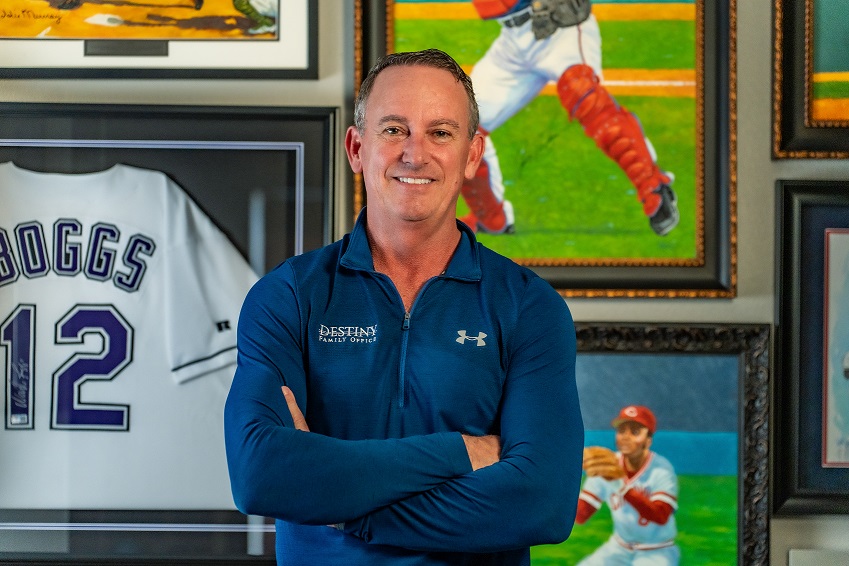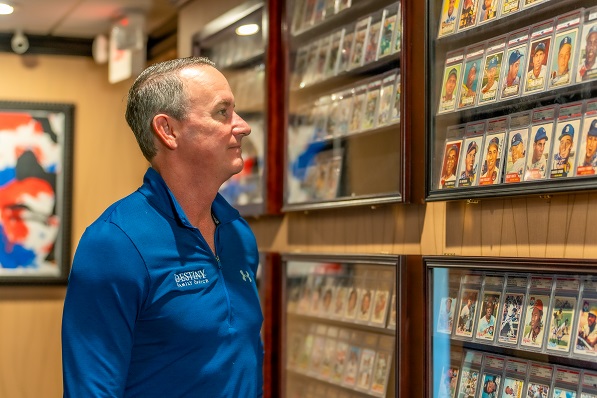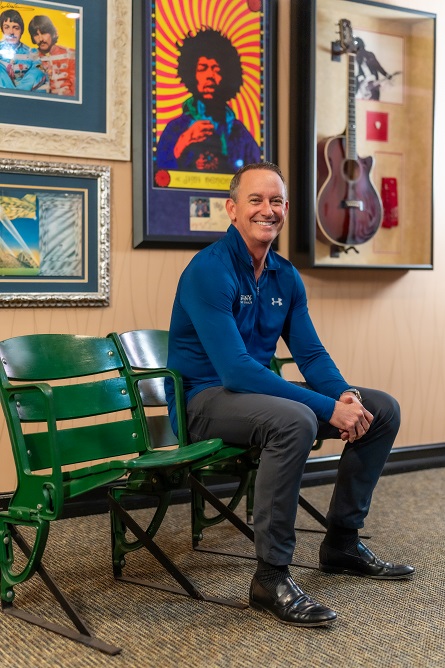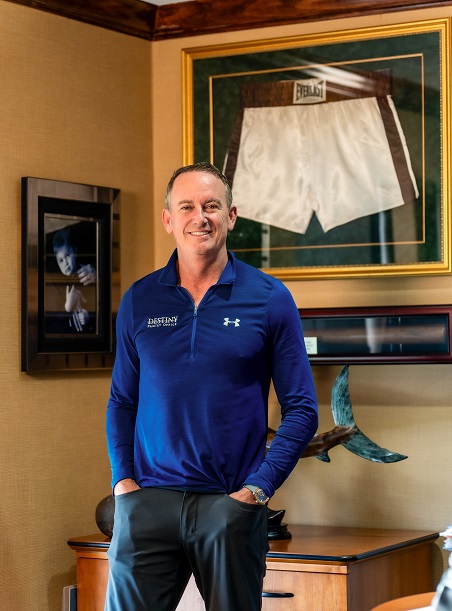Collectibles and Investing: Q&A with Thomas Ruggie, ChFC®, CFP® - Founder & CEO of Destiny Family Office
PJ Kinsella — October 23 2024
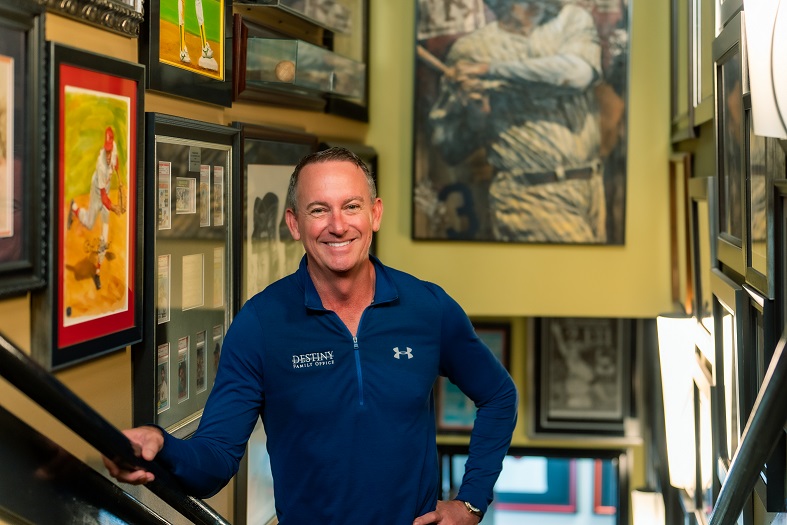
Thomas Ruggie has been collecting sports cards and memorabilia for more than three decades. He’s also an accomplished investment advisor and the Founder & CEO of Destiny Family Office where he’s coupled his love for the hobby with his extensive knowledge of the investing landscape. In this fascinating Q&A, Tom takes us through his collecting journey and offers some sound insight into both the collectibles sector as well as how many of these pieces can become powerful investment assets.
Sports cards and memorabilia are becoming a popular option in the alternative investment space. As someone ensconced in both the hobby as well as the financial sector, how do you see this evolving in the years ahead?
I’ve been collecting sports memorabilia for 50 years and have been in the wealth management space for over 33 years. Even as a young kid, I realized the importance of “investing” your money. After mowing a couple of lawns and having $20 of discretionary income, I’d evaluate whether I wanted to buy a 1968 Topps Johnny Bench rookie card or a 1959 Topps Willie Mays card. That being said, the last 10+ years have been a boom to the hobby. Yet, in my opinion, we are still in the early stages of collectors truly recognizing and addressing the financial implications of their collections.
Candidly, it wasn’t until I addressed my own personal situation that I realized I had a big (but good) problem in that my family is completely unaware of the contents, value and ultimate succession plan for my investments. My collection has increased in value so much I could no longer avoid it as not only part of my overall estate, but also as part of my overall investment platform. I realized that without even delving into the idea of collecting with investment intent, there’s so much for collectors, like me, to address in terms of estate planning, valuation, insurance, and other matters.
It was for this reason I developed a Scorecard (available on our website: Destinyfamilyoffice.com), based on my own experience and situation, but also designed to help others like me analyze all aspects of their collection from a planning perspective. It is my hope in the coming years that we see collectors begin to more seriously account for the impact that their large collections have on their perception and understanding of their overall financial well-being.
There have been a lot of new developments in recent years that have helped grow the hobby substantially, from online breaking to the sophistication around photomatching and authentication. In your opinion, what will be the biggest catalyst for growth in the industry moving forward?
The process has gone from no authentication to questionable authentication certificates, to higher levels of authentication and provenance. You can witness the difference in the price of the Babe Ruth “Called Shot” World Series jersey from substantial authentication to ironclad proof it was the jersey he wore in the game. Simply put, people are going to pay more for a collectible when there is solid proof it is a “one of a kind" collectible. The increased media attention and broader social relevance in the digital era plays a huge role. Media attention that used to be reserved only for milestone home run balls has spread to game-worn artifacts (both from present day athletes and legends) and cards, and the reach of that attention is exponentially wider because of social media.
People today have a much more acute understanding of the worth of socially relevant memorabilia which wasn’t perhaps the case 10+ years ago. Similarly, digital channels allow collectors, auction houses, authenticators, and even athletes to more effectively tell the stories associated with a piece of memorabilia to a broader audience. The internet can serve as a digital museum.
Due to this, there has been an increased interest from the broader financial community, both in terms of collectors’ advisors and institutional interest. As noted above, this is in the early innings, but we see the groundwork being laid with people like me and others considering how best to meet existing collector needs and provide access to the space (via funds or advice) for those interested but not yet intimately involved.
How did you get into collecting and is there any specific card or piece of memorabilia that you're hoping to add someday?
My collecting started in 1975 at the age of 6 when I went to my first Spring Training baseball game between the Boston Red Sox and Philadelphia Phillies (I was born in Clearwater and lived there until 9 years old, where the Phillies still train to this day). My dad purchased a signed baseball from a young kid, which I still have to this day. A year later, I purchased my first wax pack, and the following year got to the point of completing my first Topps set of cards. I loved and hated the hunt for the last few cards I needed to complete the set.
I used to literally hang over the top of the dugout to get the likes of Reggie Jackson and Pete Rose and then it dawned on me how cool it would be to have these stars sign their cards and this started a lifelong passion for the collection of autographed cards. Now, just like finishing that first Topps set I have the excitement of trying to find the last card(s) for quite a few sets. I have completed sets of ‘79, ‘80, ‘85, and ‘89 Topps, ‘83 Donruss, ‘87 Fleer, and ‘78 Topps Football. I’m currently working on ‘52, ‘53, ‘54, ‘56, ‘60, ‘61, ‘76, and ‘78 Topps, ‘51, ‘52, ‘53, and ‘55 Bowman, along with 2010 and 2011 Topps Heritage.
In addition to my signed card collection, I own about 50 original pieces of art, have quite a few signed photos of most major stars from the early 1910s to the 70’s, and have a small, but significant collection of one-of-a-kind items, such as a pair of 4-fight worn Muhammad Ali boxing trunks. The things I’d really love to add to the collection may be out of my price range at this point, but what motivates me is completing the autographed sets. For example, my signed 1952 Topps set is only short six cards and is the #1 set on the PSA Set Registry, as all are slabbed and authenticated. I no longer need any stars, just six hard-to-find signatures from the set. In case any reader could be of assistance, here are the six missing signed cards from the ‘52 set: #336 Koslo, #374 Benton, #376 Throneberry, #378 Fusselman, #381 Stock, and #386 Yuhas.
Tell us about your podcast "Significance of Wealth" and what type of insight you provide as part of the series.
The Significance of Wealth podcast was developed to focus on the three primary areas we find people are interested in within our Destiny Family Office practice. The family office is comprised of high-net-worth families and the three areas we focus on, with high-net-worth individuals as our target market, are: traditional family office needs (estate planning, investment guidance, generational planning), direct investments (we offer a lot of direct investment opportunities into private companies such as SpaceX, xAI, Anduril, etc.), and Collectibles. The focus on the collectibles market is a more recent endeavor within our practice, stemming from my own planning issues already discussed but also purely from the overlay of passion for incorporating my love of collecting with my passion for working with individuals who will benefit from my knowledge and wisdom in both the wealth management and collectible space. About 77% of high-net-worth individuals have a significant collection of some kind.
You're starting a collection from scratch and you can add any four cards you want to start. What four are you choosing?
From my perspective, it would be autographed cards and I’m going to answer the question with two answers, one from an investment standpoint and the other from a standpoint of my favorite cards:
Investment: T206 Ty Cobb, 1933 Goudey Babe Ruth, 1952 Topps Jackie Robinson and 1952 Topps Mickey Mantle.
Favorite cards, more from an aesthetic standpoint: 1951 Bowman Willie Mays, 1953 Topps Satchell Paige, 1953 Bowman Pee Wee Reese and 1964 Topps Pete Rose.

